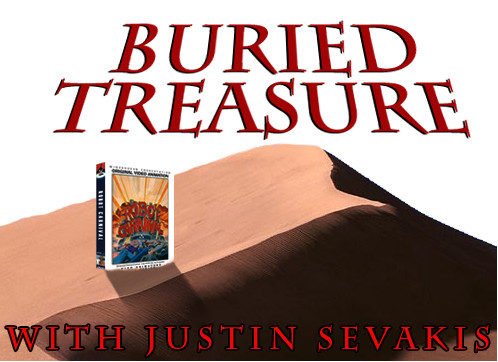Buried Treasure
Winter Days
by Justin Sevakis,
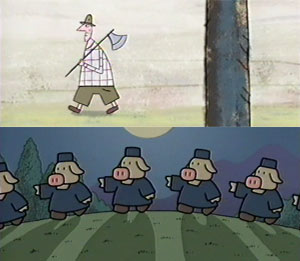 This is my second attempt at writing a column on the 2004 anthology film Winter Days. Last week around this time I sat at my keyboard, my fingers poised motionless above the home keys, pondering what insights I could possibly provide on this film. The minutes ticked by and when my deadline came I had managed to convey only a paltry few vague and unenthused paragraphs. We decided to ditch the column for the week.
This is my second attempt at writing a column on the 2004 anthology film Winter Days. Last week around this time I sat at my keyboard, my fingers poised motionless above the home keys, pondering what insights I could possibly provide on this film. The minutes ticked by and when my deadline came I had managed to convey only a paltry few vague and unenthused paragraphs. We decided to ditch the column for the week.
Privately, having to do that drove me nuts. The next night over drinks, I told my tale of woe to an old friend of mine I've known since film school. He's not an anime fan, but generally has good, if simple tastes. He asked what the film was about.
"Well," I began as I glugged down some wine, "they took a collaborative poem by a famous 17th century haiku poet and his friends, gave each two stanza exchange to an animator -- 35 animators in all -- and each of them came up with a minute-long short film."
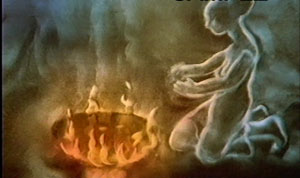 "That sounds unwatchable," my friend replied. I shrugged and agreed, at least, that it was pretentious. "35 minute-long animated versions of a section of 400-year-old poetry? No, that's not pretentious at all!" he laughed.
"That sounds unwatchable," my friend replied. I shrugged and agreed, at least, that it was pretentious. "35 minute-long animated versions of a section of 400-year-old poetry? No, that's not pretentious at all!" he laughed.
"36. The producer got to go twice," I muttered.
A week later, I sit here again, fingers poised over the home keys, musing over this film. That conversation keeps coming back to me. Had I made the same mistake that so many in artistic circles make, and mistaken artistic intent for artistic merit?
 I'm sorry to say that this may be the case. At the very least, Winter Days is challenging viewing. If I'm to be entirely honest, it took me three tries to finish it, and it's only forty minutes long. And yet, as a fan of animation as a medium, it is impossible for me to dismiss it entirely. For not only does it contain seldom seen work by some of anime and animation's undisputed masters, but it also has moments of True Beauty.
I'm sorry to say that this may be the case. At the very least, Winter Days is challenging viewing. If I'm to be entirely honest, it took me three tries to finish it, and it's only forty minutes long. And yet, as a fan of animation as a medium, it is impossible for me to dismiss it entirely. For not only does it contain seldom seen work by some of anime and animation's undisputed masters, but it also has moments of True Beauty.
Matsuo Basho (1644-1694) was one of the originators of the haiku, known for expressing the deep emotions of a particular moment in just a few choice syllables. His work often reflected the daily life of a commoner, for whom life in those days was exceedingly difficult. His book of collected works, known as Winter Days, is regarded as one of the seminal works of Japanese literature. Many of his poems are written collaboratively with about five others, with each poet adding a stanza after reading only the one preceding it.
 For the animated version, each artist got only two stanzas to work on -- the call and the response -- with which to animate a short work. Anime fans should immediately recognize Isao Takahata on the roster; others include Yuri Norstein -- a groundbreaking Russian animator referred to frequently as an inspiration of Hayao Miyazaki, Oscar-nominee Kōji Yamamura (Mt. Head), Stray Sheep designer Tatsutoshi Nomura, and many others.
For the animated version, each artist got only two stanzas to work on -- the call and the response -- with which to animate a short work. Anime fans should immediately recognize Isao Takahata on the roster; others include Yuri Norstein -- a groundbreaking Russian animator referred to frequently as an inspiration of Hayao Miyazaki, Oscar-nominee Kōji Yamamura (Mt. Head), Stray Sheep designer Tatsutoshi Nomura, and many others.
Every possible animation medium is explored, from 3D CG to puppets to paint-on-glass. Every style is represented, from the childish linework of an animated fairy tale to pensive, regretful moments driven into memory with deep impressionistic lines. Delicate ink brushwork in one scene (by Reiko Yokosuka) gives way a minute later to a digital composite of pastel work and doll animation (by Yūko Asano).
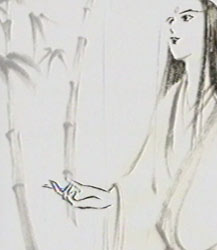 Some of the segments are absolutely breathtaking. Yokosuka's and Norstein's pieces in particular stand out as unique artistic achievements. (Norstein's is a particularly memorable account of an exchange between two old peasants in feudal Japan.) Unfortunately the short running times limit each piece's thematic and story reach; most simply resort to visual fireworks representing the poetry.
Some of the segments are absolutely breathtaking. Yokosuka's and Norstein's pieces in particular stand out as unique artistic achievements. (Norstein's is a particularly memorable account of an exchange between two old peasants in feudal Japan.) Unfortunately the short running times limit each piece's thematic and story reach; most simply resort to visual fireworks representing the poetry.
That said, some stanza pairs seem nonsensical, or at least meaningless. That some of the animators agree with this means that at least partially, the intent of the film has been lost: that the poem and the film would mimic the poetry's pattern of call-and-response, a study in the stimulus-response of human expression over the distance of four centuries. Some of the artists simply had no response, and churned out meaningless work out of obligation.
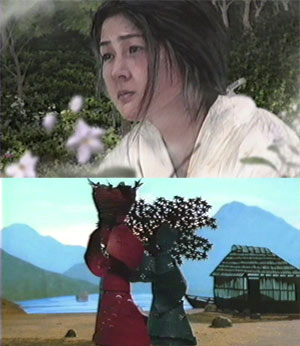 While this, no doubt, further limits the overall artistic success of the film, I would make the argument that the project was likely ill-conceived in the first place. Film tends to lend itself to longer narratives, or at least themes. A patchwork construction of visual responses to a poem is unlikely to gel into any sort of cohesive work. There's little meat behind any mood or expression here.
While this, no doubt, further limits the overall artistic success of the film, I would make the argument that the project was likely ill-conceived in the first place. Film tends to lend itself to longer narratives, or at least themes. A patchwork construction of visual responses to a poem is unlikely to gel into any sort of cohesive work. There's little meat behind any mood or expression here.
Despite all that, I maintain that Winter Days is a "Buried Treasure". The film will undoubtedly be of interest to students of animation and of Japanese literature, as well as hardcore fans of individual animators. While one might simply spend the experience soaking in the lush imagery, another might ponder the alternative meanings being read into the poem by each artist.
But I must admit there's less here than I originally thought there to be. And for those without serious humanist leanings, the viewer is more likely to be bored out of their minds. Be that as it may, it proves that sometimes the intent behind a project is more respectable than its final result, but that doesn't mean that its parts are a total waste.
| Obscure-O-Meter™ | |
| A | Abundant. Available anywhere that carries anime. |
| C | Common. In print, and always available online. |
| R1 | US release out of print, still in stock most places. |
| R2 | US release out of print, not easy to find. |
| R3 | Import only, but it has English on it. |
| R4 | Import only, no English version. |
| R5 | Import only, and out of print. |
| R6 | Import out of print and rare. |
| R7 | Very rare. Limited import release or aired on TV with no video release. |
| R8 | Never been on the market. Almost impossible to obtain. |
Do digital fansubs exist*? NO | |
| Adapted from Soviet-Awards.com. *at the time of writing, to the best of our knowledge. | |
No publicly released subtitled version exists to my knowledge; your best bet in seeing this film is to get either the (quite expensive) Japanese release, or the identical and much cheaper Korean edition. Neither has English subtitles, but a translation of the poem can be found online, and the animated sequences don't really have any dialogue. (Unfortunately you're on your own for the making-of segment.) If you're a hardcore animation buff, there's a Japanese edition with over 8 DVDs of supplemental behind-the-scenes material in addition to the film. As you can probably guess, it ain't cheap -- over $300.
discuss this in the forum (27 posts) |
